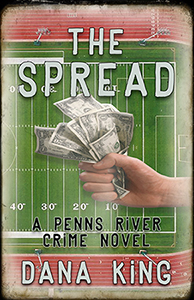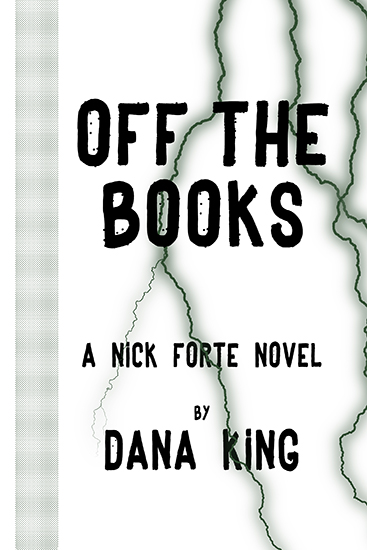Just because my books are straight white male oriented doesn’t mean I’m not sensitive to those who aren’t straight white males. I’m a straight white male, so those are the characters I’m most comfortable writing. I’ve tried to make my books more diverse over the years, but it can be awkward for someone of my background.
This past spring’s Malice Domestic conference brought Queer
Crime Writers to my attention. I spoke with a friend of mine who is a member
and he suggested I get in touch with John Copenhaver, who I knew casually.
Today John answers my questions about QCW, as well as
talking about some of the hurdles queer writers and characters have to clear,
and what straight cisgendered writers can do to help. I learned a lot, and my
future books will be better for it.
One Bite at a Time: Thanks for coming on the blog,
John. It’s great to have you.
Queer Crime Writers is a relatively new organization,
founded in 2019. What was the motivation to begin the group?
John Copenhaver: From the beginning, QCW was Kristen
Lepionka’s brainchild. She identified the need early on. There was no
centralized community or support network for queer crime writers aside from a
few Facebook groups. Kristen reached out to Jeff Marks and me, and we began
brainstorming. We’d seen the great things that Crime Writers of Color had
accomplished, and we wanted to create a similar organization to support
aspiring and published LGBTQ+ writers. Then, COVID hit, and life became much
more complex. Eventually, we began meeting and established a groups.io chat and
a website. We also added more organizers, including Stephanie Gayle and Marco
Carocari.
OBAAT: The QCW mission statement reads, in part, “to promote
community and collaboration among authors of crime fiction who identify as
LGBTQIA+.” How do you do that?
JC: We began with a groups.io chat that established a
closed, queer crime writers-only space to come together, share ideas, network,
and celebrate each other’s work. This in-facing community-building aspect is
central, but we also want ourselves to be a resource for readers and the
broader crime writing community, so we developed a website that features our
authors, their books (as well as books of notable LGBTQ crime writer luminaries),
and an events calendar. We also established a relationship with CrimeReads to
publish a quarterly round-up of queer crime books coming out seasonally. We produce
a quarterly newsletter and invite liaisons with established crime writing organizations
like Mystery Writers of America, Bouchercon, International Thriller Writers,
Left Coast Crime, etc. We also hope to continue to be a presence at conferences
by hosting a table and Queer Crime Writer meet-up whenever possible.
OBAAT: I used to work for a company that sent its
pre-sales technical staff (such as myself) to customer sites to conduct what
they called FIND interviews. “FIND” stood for Facts, Issues, Needs, and Dreams.
How would you answer those from a QCW perspective?
·
What are the facts of the situation as they
exist today?
JC: Queer-identifying crime writers are still
underrepresented in publishing and in the broader crime reading and writing
community. For instance, in 2023 crime fiction anthologies featured a total of
517 stories across 30 titles. Five out of 517 stories were written by LGBTQ+
writers. That’s less than 1 percent. That’s not acceptable. Of course, we
understand we are a majority, but the stats don’t fit the size of the
population of queer crime writers.
·
What issues do you face?
JC: Homophobia and transphobia in the publishing,
writing, and reading community. While I’m sure some folks are openly biased, I
believe most of it is an unconscious bias that emerges in the mind of the biased
publisher, editor, agent, writer, reader, or event organizer as a preference or
aesthetic sensibility. They can’t imagine a tough guy detective who
likes men or a trans lawyer who is a bad-ass lawyer. They say to themselves
that the book’s not for them or that the book won’t sell, but that’s just unconscious
bias playing out, and it’s a failure of imagination. If we can move beyond that
unconscious bias, we can make real strides. To do so means getting the
community to discover the imaginative joy of reading and writing a
counternarrative, the thrill of telling a story about a queer character that’s
surprising because it breaks down old stereotypes.
·
What do you need to happen?
JC: We need allies to reach out, offer support, and
read our books. If you read a wonderful queer mystery or thriller, tell folks
about it, share it on social media. If you are building a panel or event, reach
out to us or our members. While it’s wonderful to have a strong and supportive
in-facing community, it’s getting the greater crime reading and writing
community involved that’s necessary for lasting change.
·
In this context, what would a perfect world look
like?
JC: In a perfect world, we’d have no need for this
organization because our stories would whole equal status in the minds of
mainstream publishing and have a broad readership.
OBAAT: Full disclosure: I am an aging (68 years old),
straight, cisgendered, white male. What should I be aware of to most accurately
and fairly depict LGBTQIA+ characters?
JC: So, I’ve been on many
LGBTQ+ writers' panels, and we’re often asked a question similar to yours.
Usually, a panelist will say: “do your research,” or “do your homework,” or
mention some tropes to avoid, like “the gay best friend” (i.e., queer
characters shouldn’t be the support staff for your straight journey to
self-understanding) or “bury your gays” (i.e., tragic queer characters
shouldn’t be written as fodder for straight catharsis. Don’t kill us so that
you can come to terms with your homophobia.). Most problematic LGBTQ+ tropes
result from centering straight lives in queer stories. While I’m not sure all
my fellow queer crime writers would agree, I support cis-hetero authors writing
queer characters and even making them point-of-view characters, but you
should investigate your reasons for doing so. Do you have a compelling,
humanistic reason for including character?
Are you willing to do the research? Are you willing to address your
biases, especially those sneaky unconscious biases? Or are you just trying to
chase a trend? If you’re chasing a trend, you’ll almost always fail to write a
compelling LGBTQ+ character. Also, if you plan to include queer characters, be
an advocate for queer writers.
.
OBAAT: When I was growing up and first became aware
of such things, “queer” was an insult. Now it’s a term that is self-applied. Is
the use context-dependent, or is it only appropriate for use by members who
identify as such?
JC: “Queer” as a term emerged during the 1980 in
academia and, now, has broadly been accepted as a catch-all term synonymous
with LGBTQIA+. It’s a lot easier to say than the acronym, and it’s okay for
non-queer people to use it as long as it’s spoken in a supportive and affirming
way. It’s an adjective, so it’s okay to say “Queer people” or “Queer Crime
Writers,” but avoid the noun “the queers” or “Are you a queer?” That’s offensive.
The noun version is reductive; the adjective is descriptive. My sexuality is
part of me (adjective), but not all of me (noun).
I know and appreciate that some older gay men don’t like the
term, but it’s fallen into common usage and is here to stay, I think.
OBAAT: Which straight crime writers get LGBTQIA+
characters best? Not necessarily the most flattering, but most accurately and
fairly?
JC: Laurie King did a fantastic job with her Kate
Martinelli series and has a substantial gay and lesbian following because of
it. Her new character, Raquel Laing, in Back in the Garden is also
written in a balanced and compelling fashion. When I heard about the concept of
Shawn Cosby’s Razorblade Tears, I raised my eyebrows—two men revenging
the murderers of their gay sons—but Shawn, sensitive to the issues surrounding
the portrayal of queer characters, balances the narrative beautifully. It’s a
great example of how to write a straight redemption story without reducing the
queer characters to pawns. It’s not an easy feat, but he did it effectively.
Thanks to John Copenhaver for taking the time to supply such
thoughtful and thought-provoking answers. If you’d like to learn more about
Queer Crime Writers, you can visit their
website.


No comments:
Post a Comment